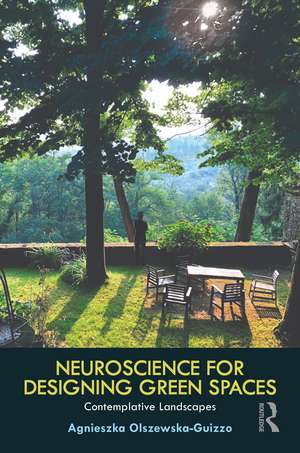Neuroscience for Designing Green Spaces: Contemplative Landscapes
Autor Agnieszka Olszewska-Guizzoen Limba Engleză Paperback – 30 mai 2023
The Contemplative Landscape Model unveils the path to answer these questions. Rooted in landscape architecture and neuroscience, this innovative concept is described for the first time in an extended format, offering a deep dive into contemplative design and the science behind it. In the face of the global mental health crisis, and increasing disconnection from nature, design strategies for creating healthier urban environments are what our cities so sorely need.
This book delves into the neuroscience behind contemplative landscapes, their key spatial characteristics, and practical applications of the Contemplative Landscape Model through case studies from around the world. Landscape architects, urban planners, students, land managers, and anyone interested in unlocking the healing power of landscapes will find inspiration here.
Preț: 243.63 lei
Nou
Puncte Express: 365
Preț estimativ în valută:
46.62€ • 50.80$ • 39.28£
46.62€ • 50.80$ • 39.28£
Carte disponibilă
Livrare economică 02-16 aprilie
Livrare express 18-22 martie pentru 19.22 lei
Preluare comenzi: 021 569.72.76
Specificații
ISBN-13: 9781032280639
ISBN-10: 1032280638
Pagini: 244
Ilustrații: 10 Tables, color; 11 Line drawings, color; 85 Halftones, color; 96 Illustrations, color
Dimensiuni: 156 x 234 x 14 mm
Greutate: 0.24 kg
Ediția:1
Editura: Taylor & Francis
Colecția Routledge
Locul publicării:Oxford, United Kingdom
ISBN-10: 1032280638
Pagini: 244
Ilustrații: 10 Tables, color; 11 Line drawings, color; 85 Halftones, color; 96 Illustrations, color
Dimensiuni: 156 x 234 x 14 mm
Greutate: 0.24 kg
Ediția:1
Editura: Taylor & Francis
Colecția Routledge
Locul publicării:Oxford, United Kingdom
Public țintă
Postgraduate, Professional, Professional Practice & Development, and Undergraduate AdvancedCuprins
Introduction PART 1: SCIENCE BEHIND THE CONTEMPLATIVE LANDSCAPES 1. Therapeutic Mechanisms of Urban Green Spaces 2. Brain Response to Contemplative Landscapes and Mental Health Implications 3. How to Benefit the Most from Contemplative Landscape Exposure? PART 2: CONTEMPLATIVE LANDSCAPE FEATURES 4. Character of Peace and Silence 5. Compatibility 6. Layers of the Landscape 7. Landform 8. Biodiversity 9. Color and Light 10. Archetypal Elements PART 3: EXISTING AND FUTURE APPROACHES 11. How to Design Contemplative Landscapes? Best Practices and Case Examples 12. How to Identify Contemplative Landscapes? CLM User’s Manual 13. A Vision of a Mentally Healthy City
Notă biografică
Agnieszka Olszewska-Guizzo is a landscape architect and neuroscience researcher who conducted interdisciplinary research at the University of Porto, Portugal, the University of Massachusetts-Amherst, USA, and the National University of Singapore. She is a co-founder and lead researcher at NeuroLandscape NGO and a fellow of the Centre for Urban Design and Mental Health.
Recenzii
"This fantastic book provides strong evidence of how vital our outdoor spaces are in improving health and well-being, especially post-pandemic. It shows how healthier urban environments can be achieved to mitigate the impacts of climate change, population growth, ageing, and urbanisation. It is a valuable resource for scholars, practitioners and students."
Dr Bruno Marques, President of the International Federation of Landscape Architects (IFLA), Associate Dean, Faculty of Architecture and Design Innovation, Victoria University of Wellington, New Zealand
"Creating salubrious landscapes has been a goal of landscape design as old as the landscape architecture profession. This monograph presents a very convincing case of the Contemplative Landscape Model to marry both the goal of aesthetics and health promotion value of landscapes. It will be a very useful reference for researchers, students and practitioners in the field of landscape architecture."
Dr Tan Puay Yok, Professor, College of Design and Engineering, National University of Singapore
"Whilst there is significant evidence showing the beneficial effects of nature to wellbeing, there is still so much we don’t know about cause and effect. This book presents some new arguments – including a role for our subconscious – and drawing on Jung’s model of the psyche to help account for the profound effect nature has on us, positive and negative."
Jenny Roe, Professor in Design & Health, School of Architecture, University of Virginia, USA
Dr Bruno Marques, President of the International Federation of Landscape Architects (IFLA), Associate Dean, Faculty of Architecture and Design Innovation, Victoria University of Wellington, New Zealand
"Creating salubrious landscapes has been a goal of landscape design as old as the landscape architecture profession. This monograph presents a very convincing case of the Contemplative Landscape Model to marry both the goal of aesthetics and health promotion value of landscapes. It will be a very useful reference for researchers, students and practitioners in the field of landscape architecture."
Dr Tan Puay Yok, Professor, College of Design and Engineering, National University of Singapore
"Whilst there is significant evidence showing the beneficial effects of nature to wellbeing, there is still so much we don’t know about cause and effect. This book presents some new arguments – including a role for our subconscious – and drawing on Jung’s model of the psyche to help account for the profound effect nature has on us, positive and negative."
Jenny Roe, Professor in Design & Health, School of Architecture, University of Virginia, USA
Descriere
This book delves into the neuroscience behind contemplative landscapes, their key spatial characteristics, and practical application of the Contemplative Landscape Model through case studies from around the world.
